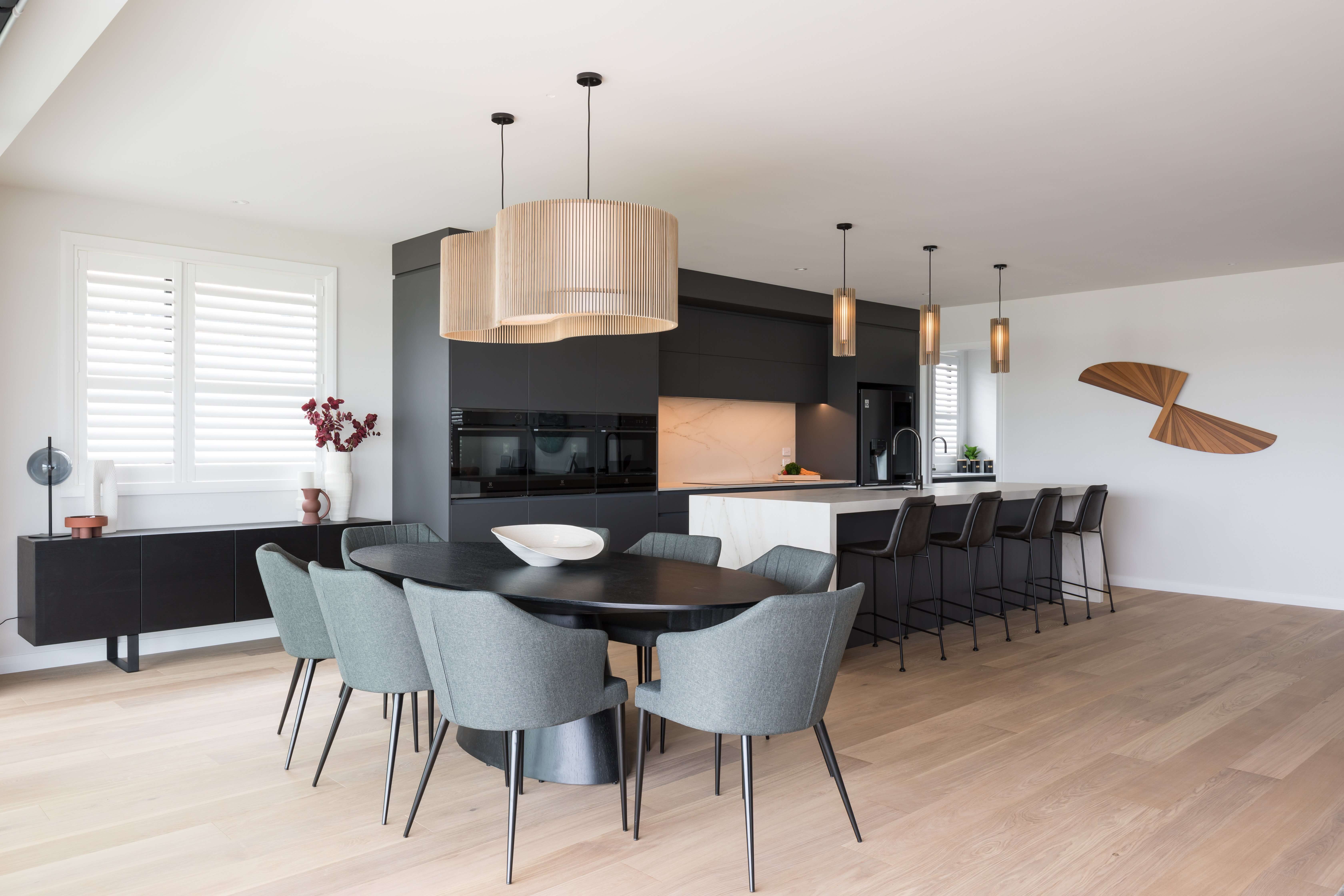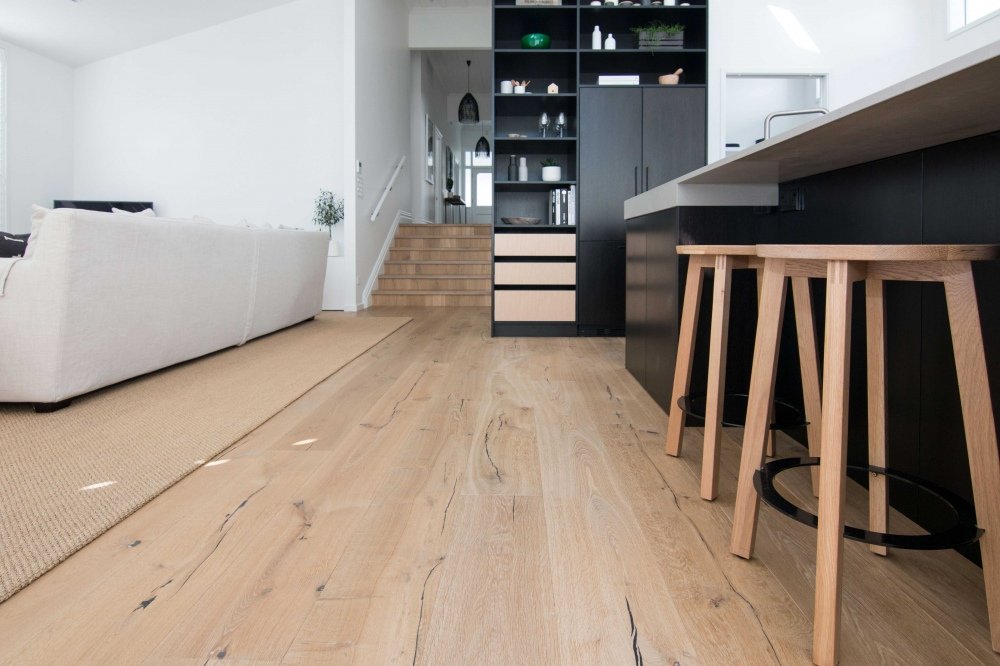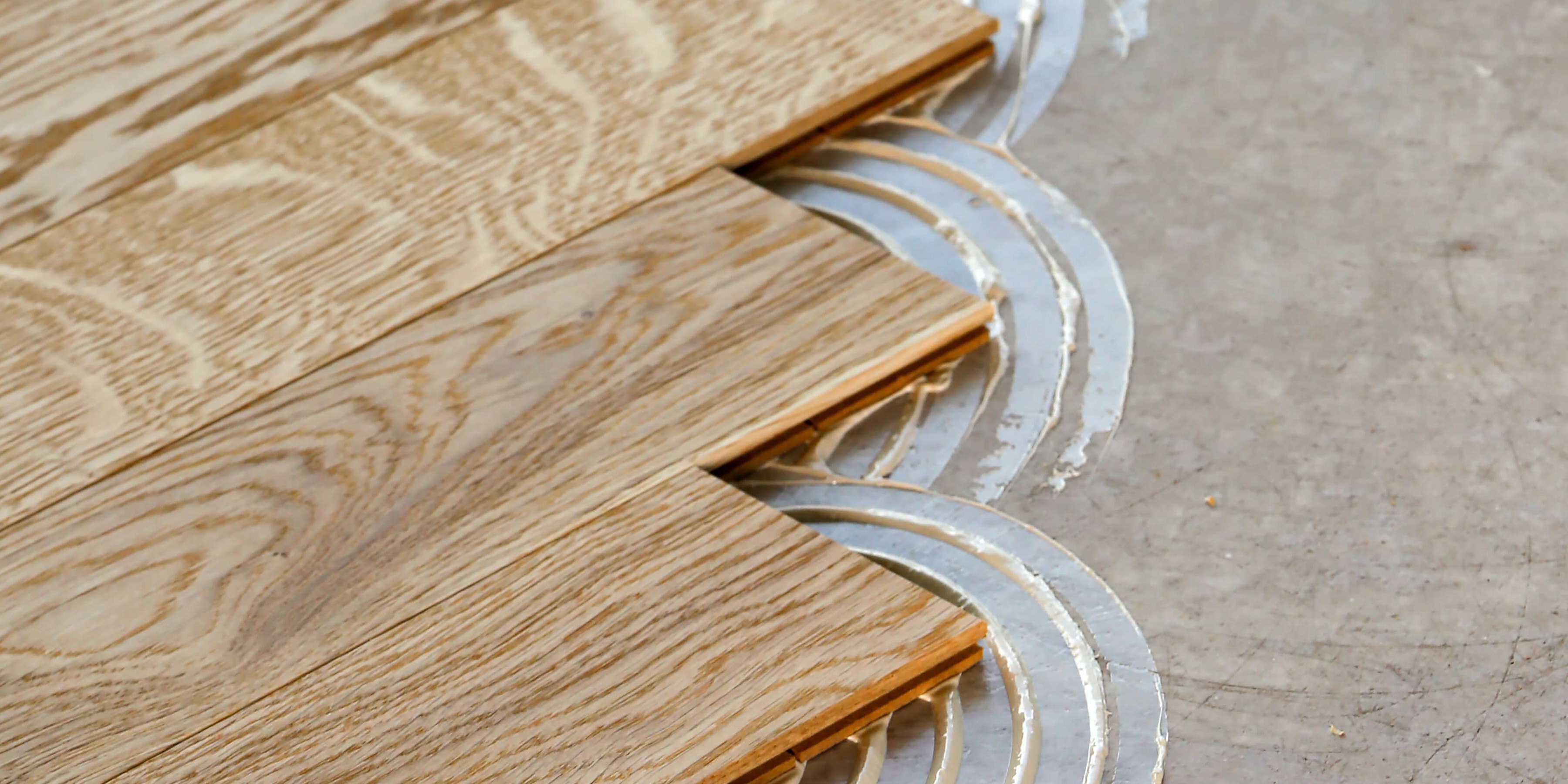Mixing wood tones in house design
Blog |
Implementing wood into your interior design is a great way to add warmth, depth and character. The question is – how can you mix different wood tones and grains within the same space?
Whether you are a professional or are planning to update your home, pairing wood items and finishes can be a challenge. In this article, we make it easier with our top 7 tips.
Why you should mix wooden flooring tones
Many homeowners like the idea of wooden floors, but might not be so keen on having the same wood type applied to all areas. This creates a problem, how do you mix different tones or patterns throughout the house.
While traditional convention outlined that mixing types of wood was a big faux-pas there have been several application of mixed wood tones or patterns that have yielded excellent results.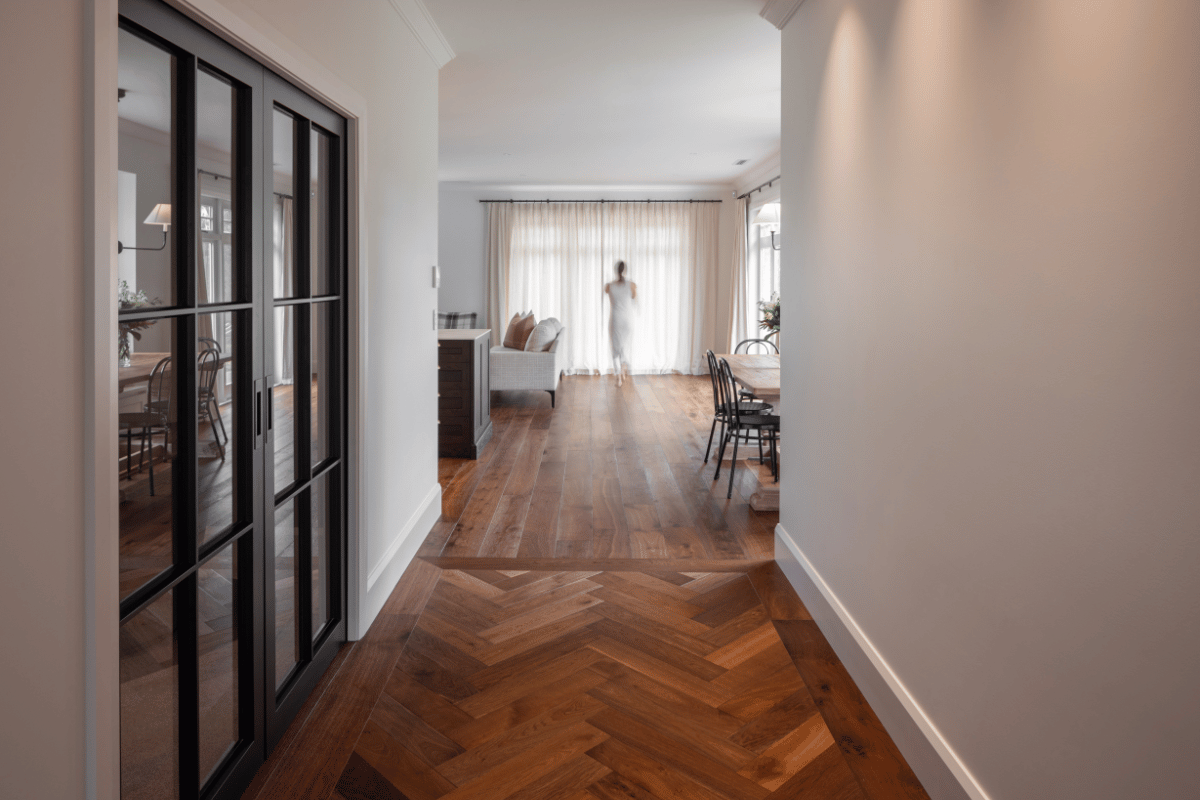 While this St Albans home uses the same Marron Oak finish in both areas it cleverly mixes the pattern in a way that defines spaces in the home, without disrupting the harmony of the environment.
While this St Albans home uses the same Marron Oak finish in both areas it cleverly mixes the pattern in a way that defines spaces in the home, without disrupting the harmony of the environment.
.jpg?width=2000&height=1333&name=_SCG4091-2%20(1).jpg) In contrast, this Ashburton home utilises differing wood tones to create an eye-catching chevron pattern within the kitchen. The main hallway then leans into the darker-toned plank, which you can see joins the chevron near the entrance.
In contrast, this Ashburton home utilises differing wood tones to create an eye-catching chevron pattern within the kitchen. The main hallway then leans into the darker-toned plank, which you can see joins the chevron near the entrance.
But how were these looks achieved and what rules can be applied to future projects to ensure there is no visual conflict between differing wood tones?
1. Choose a primary tone
First and foremost, you need to choose the main wood tone you want to use in the room. You might have a particular wood stain you want to use or have an existing piece of wood furniture, for example.
It is common for the tone of wood floors or kitchen cabinets to be the primary tone because they tend to take up the most space. The tone you choose will act as a foundation for the rest of your interior design so be sure to choose wisely.
2. Find the undertone
Next, identify whether your primary tone has a warm undertone or a cool undertone. Warm wood tones tend to appear red, orange, or yellow while cool tones look more grey or blue. If you want to add more wood tones or species, they should all have the same undertone temperature.
3. Limit your palette
To create an interior space that feels cohesive and considered, limit the palette to two or three wood tones. Any more than that and you risk the room feeling disorganised and scattered. You can still add other colours and textures to your palette, just try to avoid overdoing the timber elements.
4. Embrace contrast
Believe it or not, wood tones that are close in colour are more difficult to match than contrasting tones. Rather than trying to match your wood floors to your wood cabinets, it is often easier to choose options that look nothing alike, such as white oak cabinets with dark oak floors.
5. Use each tone more than once
To ensure your interior design feels intentional and harmonious, always use each of your chosen tones at least twice. For example, if you have chosen a dark brown oak floor, consider other places you can incorporate the same tone, such as chairs, tables, wood trim or ceilings.
This will make each element feel as though it is meant to be there and not just an afterthought.
6. Match floors and ceiling beams
If your interior has exposed timber ceilings or beams, try to choose a floor that matches. This will tie the room together from top to bottom, ensuring everything in between feels cohesive. A light wood floor paired with dark ceiling beams may appear top-heavy but, if you match them, the room gains a sense of balance.
7. Incorporate soft furnishings
If in doubt, use softer textures as a buffer between different wood tones. We recommend taking advantage of area rugs, drapes, artwork, and plants as they will add depth and layers to your space. When choosing these items, look for tones that complement your existing palette.
These tips shouldn’t just be limited to utilising different tones in your wooden flooring. As suppliers of wood panelling we see some excellent examples of mixed tones when wooden floors combine with stunning wood panelled walls. Let’s explore some popular combinations.
Popular wood pairings
To inspire your project, we’ve highlighted some of the most popular wood palettes in interior design. We also show you how these combinations look in several of our projects.
Blond, brown, and grey
 At Poured Pleats House in Ponsonby, the primary wood tone is the rich brown that is used in the cabinetry and wall panelling. The undertone is warm so our Blond Oak Feature Smartfloor was a perfect addition, along with the rustic precast concrete walls and ceiling. Reminiscent of the 70s, this palette feels warm, intimate, and moody.
At Poured Pleats House in Ponsonby, the primary wood tone is the rich brown that is used in the cabinetry and wall panelling. The undertone is warm so our Blond Oak Feature Smartfloor was a perfect addition, along with the rustic precast concrete walls and ceiling. Reminiscent of the 70s, this palette feels warm, intimate, and moody.
Ebony, white, and beige-grey
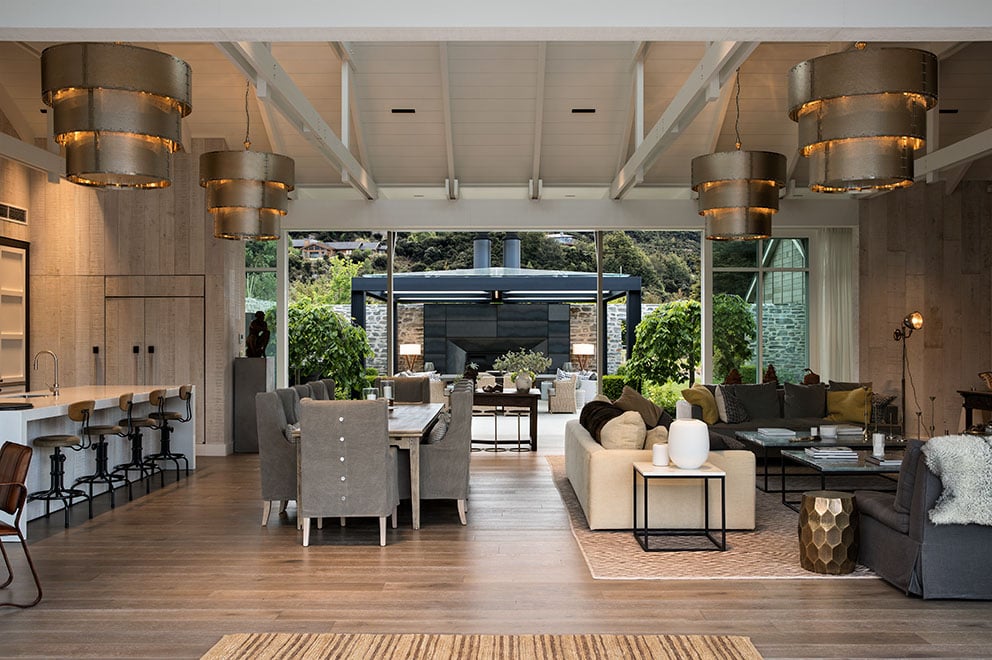 At Closeburn House in Queenstown, the interior palette is intimate, soft, and sophisticated. The primary wood tone is a soft brown found in the wall panelling and Ultra Driftwood Oak floors. The undertones are cool, so Tactile Loft White and Tactile Ebony Oak panelling were chosen for several walls.
At Closeburn House in Queenstown, the interior palette is intimate, soft, and sophisticated. The primary wood tone is a soft brown found in the wall panelling and Ultra Driftwood Oak floors. The undertones are cool, so Tactile Loft White and Tactile Ebony Oak panelling were chosen for several walls.
These tones complement the industrial style of this home, creating a cohesive foundation for the statement artwork, lighting, and world-class views.
Grey, brown, and dark wood
-2-1.jpg?width=5545&height=3697&name=Higgs_House%20(1)-2-1.jpg) At Higgs House in Northcote Point, the primary wood tone is the rich brown cabinetry which is so dark it’s almost black. The undertones are cool, so Como oak floors were chosen to incorporate soft greys and pastel browns.
At Higgs House in Northcote Point, the primary wood tone is the rich brown cabinetry which is so dark it’s almost black. The undertones are cool, so Como oak floors were chosen to incorporate soft greys and pastel browns.
These tones are the perfect complement to the dark wood, white cabinetry, and marble kitchen counter. In terms of texture, Como has a brushed, extra-matte surface with a raw, untouched look.
Golden, blond, and white
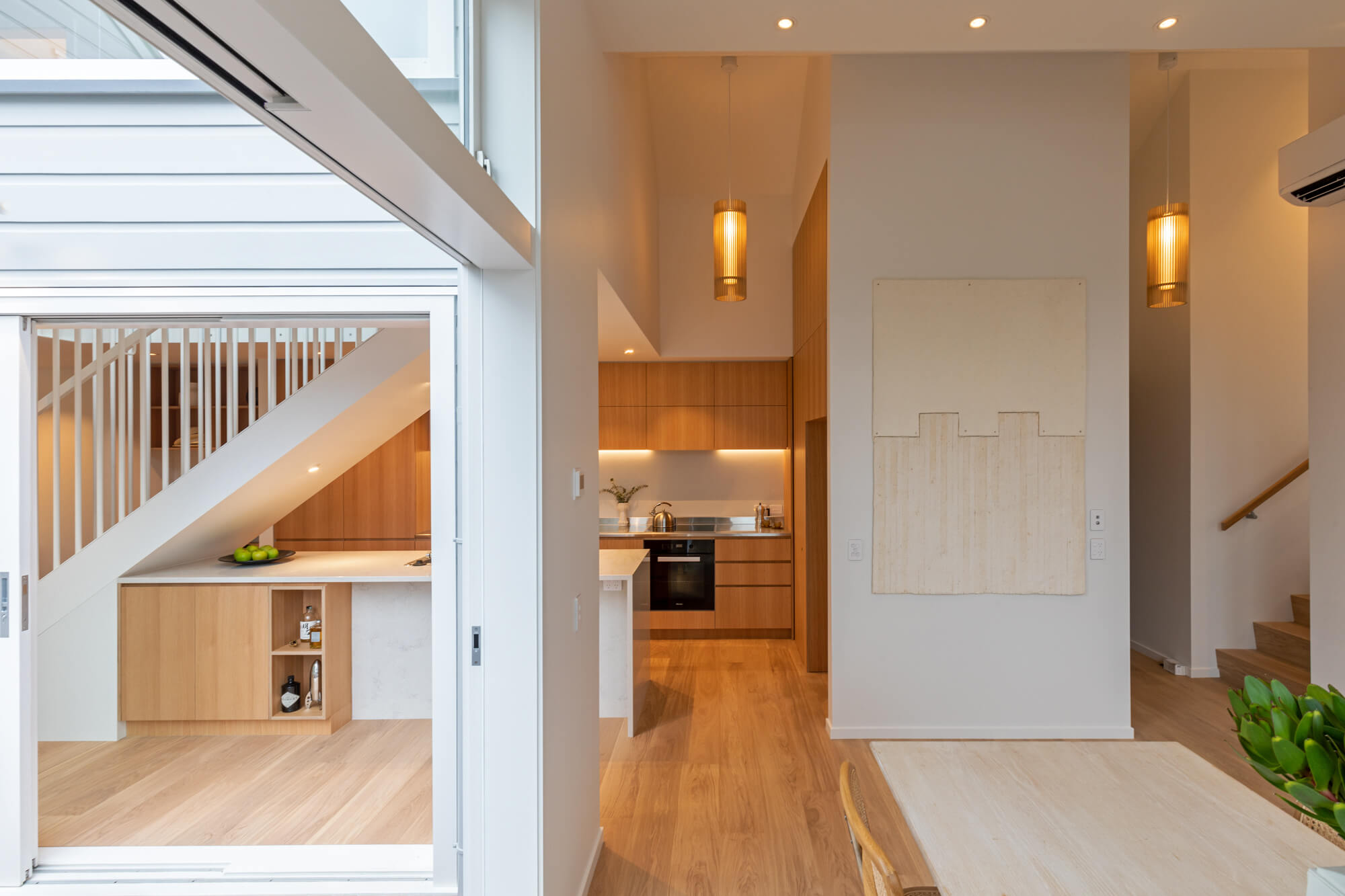 At Chappell House in Mt Wellington, the interior pallet is bright, warm, and fresh. The primary wood tone is golden with additional blond and white tones. Our Moda Capri pastel-blonde floors were used to complement this, pairing beautifully with the crisp white ceilings. The result is a space that feels spacious, airy, and inviting.
At Chappell House in Mt Wellington, the interior pallet is bright, warm, and fresh. The primary wood tone is golden with additional blond and white tones. Our Moda Capri pastel-blonde floors were used to complement this, pairing beautifully with the crisp white ceilings. The result is a space that feels spacious, airy, and inviting.
Brown and black
 The Two Barns project in Wanaka reflects the traditional alpine style, with rustic timber finishes, cedar barn doors, stone chimney, and board and batten cladding. To ensure the interior complemented this, the dark tones were carried through in blacks and browns.
The Two Barns project in Wanaka reflects the traditional alpine style, with rustic timber finishes, cedar barn doors, stone chimney, and board and batten cladding. To ensure the interior complemented this, the dark tones were carried through in blacks and browns.
Our Imondi Weathered Oak was used on the walls, adding dark shades of brown and a deeply textured patina. On the floors, our Artiste Da Vinci plank was chosen, grounding the interior with its earthy brown tone and grey highlights. In the living area and kitchen, the softer brown tones take a back seat while the black cabinetry and ceiling beams take centre stage.
Forté engineered wood floors
Our wood floors provide a reliable foundation for long-lasting, visually-appealing interiors. Whatever design style or palette you choose, find the wood ideal flooring in our extensive range, including the following tones:
Forté wood panelling
Wood panelling can add a timeless aesthetic to your interior and is the perfect addition to walls and ceilings. Whether as a feature wall or the entire room, this is a great way to add a rich texture and tone to any room. Find a suitable wood tone in our full range:
If you’re looking for the perfect timber elements to incorporate into your interior design, the team at Forté is here to help. We take pride in our premium timber products, offering you the following benefits:
- All wood flooring collections are sustainably sourced and low in formaldehyde
- Exclusive designs suitable for New Zealand’s diverse climates
- Strict quality control processes ensure consistent quality
- A nationwide network of approved craftsmen to install our floors
- Naturally insulating
To learn more about the benefits of our premium range, please contact our team or browse the full range on our website.
Visit one of our Showrooms
If you have any queries about our products or need help with your project, we can provide you with expert advice. Visit one of our showrooms or book a consultation with our flooring experts today.

